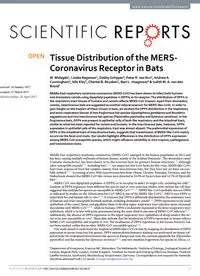
2017 Tissue Distribution of the MERS-Coronavirus Receptor in Bats PDF
Preview 2017 Tissue Distribution of the MERS-Coronavirus Receptor in Bats
1 Scientific RepoRts | 7: 1193 | DOI:10.1038/s41598-017-01290-6 www.nature.com/scientificreports Tissue Distribution of the MERS- Coronavirus Receptor in Bats W. Widagdo1, Lineke Begeman1, Debby Schipper1, Peter R. van Run1, Andrew A. Cunningham2, Nils Kley3, Chantal B. Reusken1, Bart L. Haagmans1 & Judith M. A. van den Brand1 Middle East respiratory syndrome coronavirus (MERS-CoV) has been shown to infect both humans and dromedary camels using dipeptidyl peptidase-4 (DPP4) as its receptor. The distribution of DPP4 in the respiratory tract tissues of humans and camels reflects MERS-CoV tropism. Apart from dromedary camels, insectivorous bats are suggested as another natural reservoir for MERS-like-CoVs. In order to gain insight on the tropism of these viruses in bats, we studied the DPP4 distribution in the respiratory and extra-respiratory tissues of two frugivorous bat species (Epomophorus gambianus and Rousettus aegyptiacus) and two insectivorous bat species (Pipistrellus pipistrellus and Eptesicus serotinus). In the frugivorous bats, DPP4 was present in epithelial cells of both the respiratory and the intestinal tract, similar to what has been reported for camels and humans. In the insectivorous bats, however, DPP4 expression in epithelial cells of the respiratory tract was almost absent. The preferential expression of DPP4 in the intestinal tract of insectivorous bats, suggests that transmission of MERS-like-CoVs mainly occurs via the fecal-oral route. Our results highlight differences in the distribution of DPP4 expression among MERS-CoV susceptible species, which might influence variability in virus tropism, pathogenesis and transmission route. Middle East respiratory syndrome coronavirus (MERS-CoV) emerged in the human population in 2012 and has been causing multiple outbreaks of human disease, mainly in the Arabian Peninsula1. The dromedary camel (Camelus dromedarius) has been shown to be the reservoir host for primary human infections2–8, although other susceptible animals9–11, including bats12, 13, are suspected also to be hosts for this virus. MERS-like-CoVs have been sequenced from bat samples, mainly from insectivorous bats, but they have not yet been success- fully isolated14–21. Screening of over 5000 insectivorous bats from Ghana, Ukraine, Romania, Germany, and the Netherlands showed that MERS-CoV-like viruses were detected in 24.9% of Nycteris bats and 14.7% of Pipistrelle bats17. MERS-CoV uses dipeptidyl peptidase-4 (DPP4) as its receptor to infect its target cells, including bat cells22. Analysis of DPP4 sequences from different bat species and in-vitro infection studies with various bat cell lines suggested that multiple bat species are susceptible to MERS-CoV12, 21, 23. MERS-like-CoVs probably also use DPP4 as indicated by studies on the Tylonycteris bat CoV HKU4, one of the MERS-like-CoVs21. HKU4 uses DPP4 to infect both bat and human cells in vitro24, 25. It is known that DPP4 is differently distributed in the respiratory tract of humans and other susceptible livestock animals, including dromedary camels9, 26. DPP4 expression in the nasal epithelium of the camel, llama, and pig allows them to develop upper respiratory tract infection upon intranasal inoculation with MERS-CoV2, 9, 26, while in humans, DPP4 is exclusively expressed in the lower respiratory tract epithelium, which is in line with acute pneumonia being the main clinical outcome of MERS-CoV infection26, 27. Additionally, the absence of DPP4 expression in the upper respiratory tract epithelium of sheep renders this tis- sue to be non-susceptible in-vivo9. These data indicate that the localization of DPP4 expression in tissues reflects MERS-CoV susceptibility and tropism in vivo. The localization of DPP4 expression in bat tissues, however, has not been studied, unlike that in other MERS-CoV susceptible species9, 26. Our study aimed to understand the tropism of MERS-like-CoVs in bats by mapping the distribution of DPP4 expression in tissues from four bat species. DPP4 immunohistochemistry staining was performed on tissues col- lected from two widespread insectivorous bat species in Europe and Asia, the common pipistrelle bat (Pipistrellus pipistrellus) and the serotine bat (Eptesicus serotinus)28, 29; and two common frugivorous bat species in Africa, i.e. 1Department of Viroscience, Erasmus MC, Rotterdam, The Netherlands. 2Institute of Zoology, Zoological Society of London, Regents Park, London, United Kingdom. 3Institute for Novel and Emerging Infectious Diseases, Friedrich Loeffler Institute, Greifswald, Mecklenburg-Vorpommern, Germany. Correspondence and requests for materials should be addressed to B.L.H. (email:
